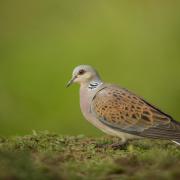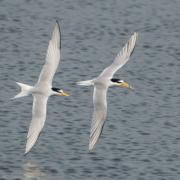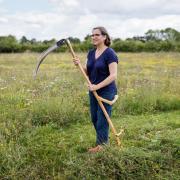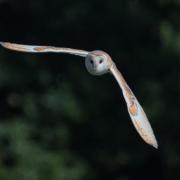With winter still crunching under his walking boots, Suffolk County Council's countryside manager, David Falk, heads down to the water to discover refreshing spring treats with a difference
With winter still crunching under his walking boots, Suffolk County Council’s countryside manager, David Falk, heads down to the water to discover refreshing spring treats with a difference
With snowy weather on the Suffolk menu well before the last feast of Stephen, it’s no surprise that everyone’s constitution is about ready for a large helping of spring greens by this stage of the New Year. Down by the Deben, not so far from Sutton Hoo, head a little deeper into the countryside and there’s a whole hoard of colourful treasures sparkling in the frosty late winter sun just waiting to be discovered.Bromeswell Green could so easily conjure up visions of vast verdant swathes bordered by proud Georgian fa�ades. In reality it is far from all madding crowds (except the occasional flock of waders), and bears no resemblance whatsoever to village idylls of communal emerald lawns contrasting with iconic sweetie-pink cottages. In a strange sort of way, it has more in common with the county’s drier mega-Green at Mellis or the ancient grazing greens at Wortham up near the Norfolk borders. Bromeswell Green is simply green by name and literally green by nature.Not so very far from bustling Woodbridge, right on the tidal Deben’s edge as the river bed widens before Wilford Bridge, this hidden little nature reserve dissected by Common Lane is an oasis of tough reedy grasses on one side and bright wet meadowlands and mossy woods on the other. Greenshanks grace its mudflats, so too posses of peewits sporting winter white throats and iridescent dark green and purple plumage. Pea-green woodpeckers and their spotted counterparts whizz around the wet woodland and tiny yellow-green siskins are a delight to watch picking at the alder seeds. Bromeswell Green and binoculars go great together, but do be warned and come armed (or should that be footed?) with wellies or good walking boots too: even when there’s a perfect blue shimmer of Suffolk sky up above and a certain satisfying frosty crunch underfoot, this is no place for giant footsteps. Nearby Newbourne might be though. Further south, on the other side of the Deben, the tiny country village was where the aptly named Meadows Page and his brother George, took life in an unbelievably large stride in the late 1800s. Each measuring about 7ft 7ins, the giant siblings lived in a remarkably minute house, just around the corner from another amazing natural phenomenon – Newbourne Springs. Now here’s a place for spring greens, if ever there was one: a secret wonderland of a wooded valley where even on the chilliest day, fresh water pushes up from the deep, feeding streamlets destined later to join the great Deben itself. The spring-fed stream was once a source of water for Felixstowe; these days it’s the local wildlife which enjoys its refreshing trickles, the lush green fenny meadows, stretches of damp alder carr and adjacent heathland. Blue tits and chaffinches dart and twitter by the score. In the unspecified distance, some old boy of a pheasant nurses his wintery cough. Down by one of the spring eyelets, a bright flash of white together with a pair of yellow feet and sharp needle beak betrays the precious presence of a little egret. The hushed woodland paths lead a pleasant circular spring dance gently up the valley side past hazel and hawthorn and round through towering alder wrapped in thick bandages of deepest green ivy. Here’s home to one of the reserves most charming little chaps – the agile treecreeper. It has to be a case of love at first scurry with this most fascinating of creatures as it climbs in nervous fits and starts vertically up tree trunks and the underside of the branches. Catch its movements out the corner of your eye and you’d be forgiven for expecting to see a squirrel; get a glance of its tiny fluffy grey softness and it could so easily be a mouse; get an eyeful through the binoculars and its unique curved beak is a sure giveaway. Thanks to its sheer variety of habitats and associated wildlife, Newbourne Springs is a designated Site of Special Scientific Interest and cared for by the Suffolk Wildlife Trust on behalf of Anglia Water.For more details about these countryside sites including map references and guidance on how to get there, visit Suffolk County Council’s official countryside website: www.discoversuffolk.org.uk
GREEN DAYS
Reserve collection Suffolk Wildlife Trust alone has 51 nature reserves and wildlife sites to explore throughout Suffolk. Together with the 127 woodland habitats managed by the Woodland Trust and five RSPB reserves, these make for plenty of choice when it comes to countryside encounters. River round up Take a circular walk on the borders by the Stour in the Dedham Vale or the Waveney picking up part of the Angles Way, or explore Mid Suffolk’s Gipping Valley or the delightful Lark Valley Path near West Stow on the outskirts of Bury. You’ll find a great range of countryside walks and all Suffolk’s open access sites including map references and guidance on how to get there, at www.discoversuffolk.org.uk


























